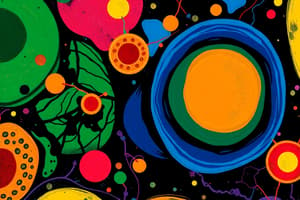Podcast
Questions and Answers
What are the structural units of all living things?
What are the structural units of all living things?
Cells
Approximately how many cells does the human body have?
Approximately how many cells does the human body have?
50 to 100 trillion
According to the cell theory, a cell is the basic structural and functional unit of living organisms.
According to the cell theory, a cell is the basic structural and functional unit of living organisms.
True (A)
The activity of an organism is independent of the activities of its cells.
The activity of an organism is independent of the activities of its cells.
What elements are most cells composed of?
What elements are most cells composed of?
What are the three main regions of a generalized cell?
What are the three main regions of a generalized cell?
What is the role of DNA in the cell?
What is the role of DNA in the cell?
The plasma membrane is permeable to most water-soluble molecules.
The plasma membrane is permeable to most water-soluble molecules.
What model describes the arrangement of the plasma membrane?
What model describes the arrangement of the plasma membrane?
Match the following components of the nucleus with their functions:
Match the following components of the nucleus with their functions:
What role do proteins play in the plasma membrane?
What role do proteins play in the plasma membrane?
Which of the following describes tight junctions?
Which of the following describes tight junctions?
Study Notes
Cells and Tissues
- Cells are the basic structural units of all living organisms.
- The human body is composed of approximately 50 to 100 trillion cells.
The Cell Theory
- A cell serves as the fundamental structural and functional unit of life.
- Organism activities depend on the harmonious functions of their cells.
- The principle of complementarity states that a cell's structure dictates its function.
- Cellular continuity is essential for the existence of life.
Cell Composition
- Most cells consist of four key elements: carbon, hydrogen, oxygen, and nitrogen.
- Cells contain about 60% water.
Anatomy of a Generalized Cell
- A typical cell has three main components:
- Nucleus
- Cytoplasm (the gel-like substance within the plasma membrane)
- Plasma membrane
The Nucleus
- Functions as the cell's control center.
- Houses genetic material known as DNA, crucial for:
- Protein synthesis
- Cellular reproduction
- Main regions include:
- Nuclear envelope (double membrane with nuclear pores)
- Nucleolus (site of ribosome assembly)
- Chromatin (DNA and proteins that condense into chromosomes during cell division)
The Plasma Membrane
- Acts as a transparent barrier that encases cell content and separates it from the external environment.
- Constructed based on the fluid mosaic model, which includes:
- Two layers of phospholipids arranged tail-to-tail
- Scattered cholesterol and proteins
- Possible sugar groups forming glycolipids
Phospholipid Arrangement
- Hydrophilic "heads" face the outer and inner surfaces; hydrophobic "tails" are oriented inward.
- Creates a barrier that is selectively permeable to water-soluble molecules.
Functions of Membrane Proteins
- Specialized functions include:
- Enzymatic activity
- Hormone reception
- Transmembrane transport as channels or carriers
Cell Junctions
- Cells are adhered through:
- Glycoproteins in the glycocalyx acting as adhesive molecules
- Membrane contours fitting together like a jigsaw
- Specialized membrane junctions, varying in structure and function
Types of Cell Junctions
- Tight junctions create impermeable barriers, binding cells into leakproof sheets and preventing substance passage through the extracellular space.
Studying That Suits You
Use AI to generate personalized quizzes and flashcards to suit your learning preferences.
Description
Explore the foundational concepts of cells and tissues in this quiz based on Chapter 3 of Biology. Delve into the cell theory and understand the vital role of cells as the basic units of life. This is essential for grasping the fundamentals of biology and human anatomy.




